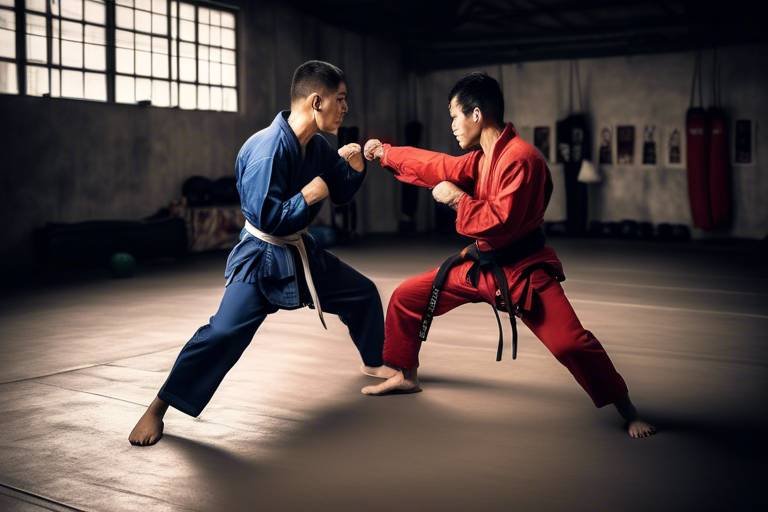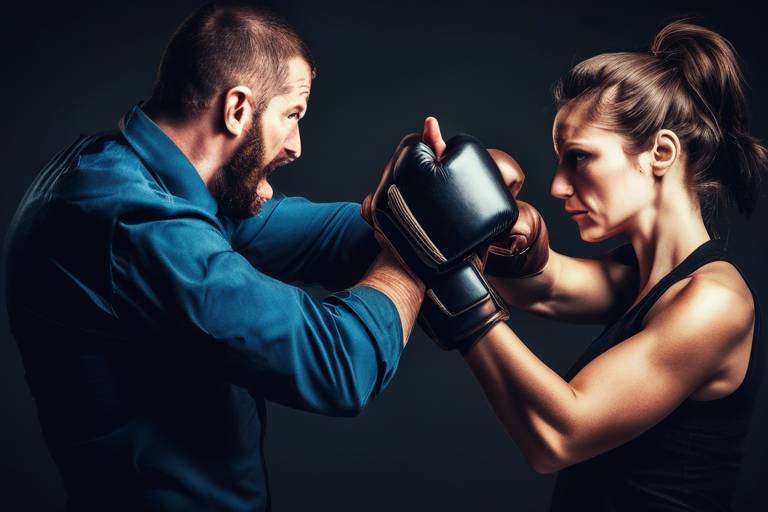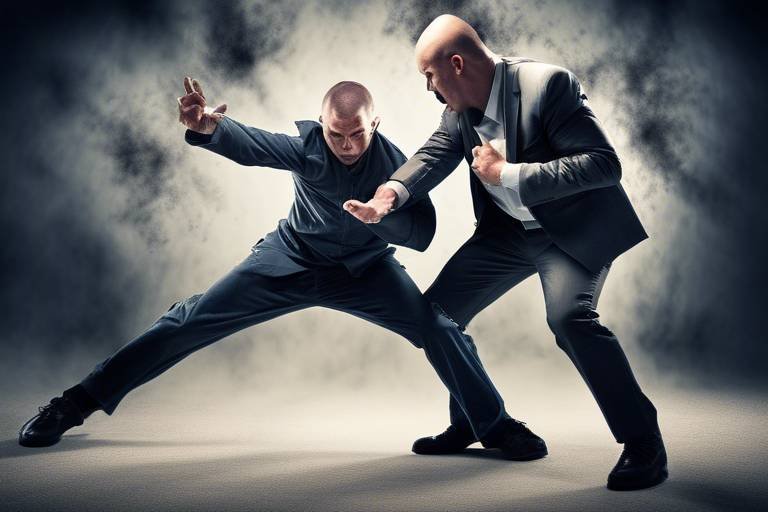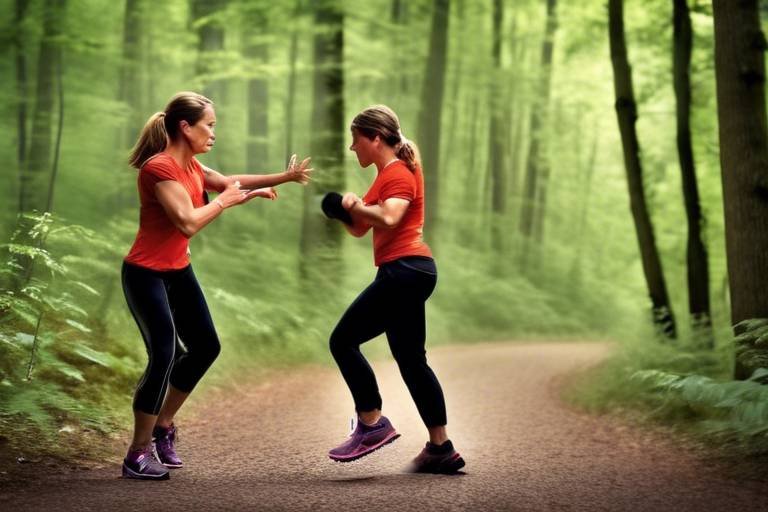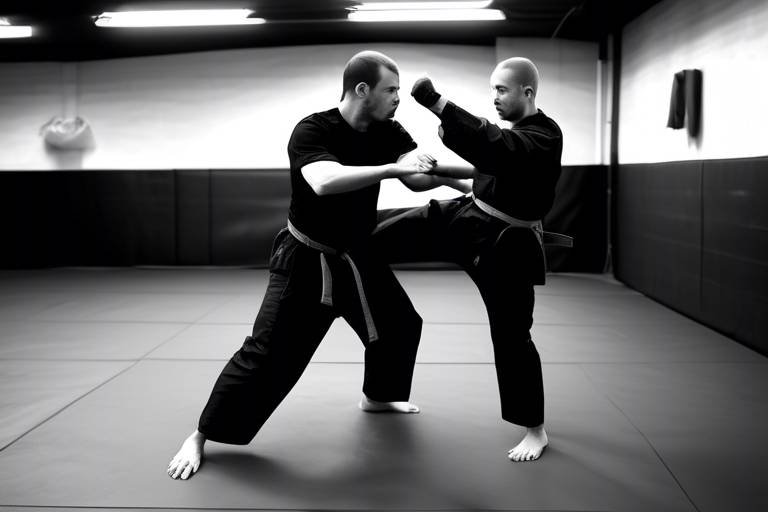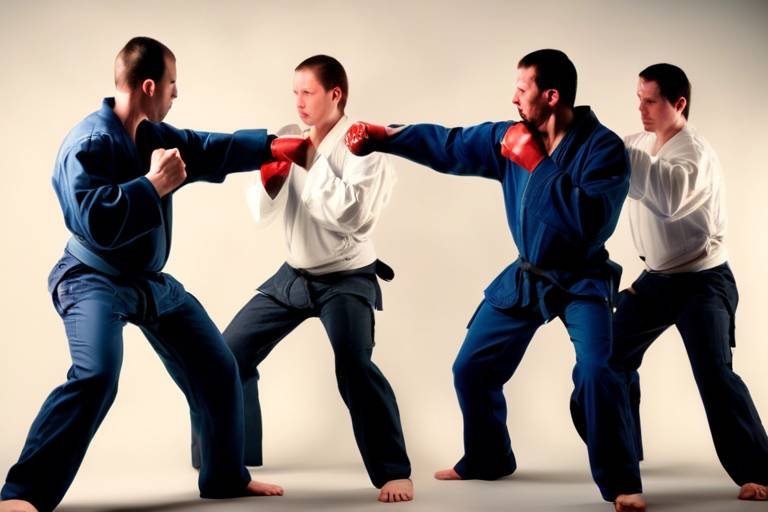Picking the Right Martial Art for Your Self-Defense Training
Choosing the right martial art for self-defense can feel a bit like picking the perfect outfit for a big event; it should fit well, feel comfortable, and make you confident! With so many styles out there, how do you know which one is best for you? This article will help you navigate the myriad of options, focusing on what you need to consider, the techniques involved, and the benefits each discipline offers. Whether you’re looking to boost your confidence, improve your fitness, or simply learn how to defend yourself, understanding the nuances of various martial arts is essential.
Before diving into the world of martial arts, it's crucial to assess your personal self-defense needs. Think about what you're hoping to achieve. Are you primarily focused on personal safety, or is fitness your main goal? Perhaps you're interested in competition or simply want to learn a new skill. By identifying your specific goals, you can better determine which martial art aligns with your needs. For instance, if your primary concern is street safety, you might prioritize styles that emphasize practical techniques over sport-oriented practices. On the other hand, if you’re looking for a fun way to stay fit, you might lean towards a more dynamic and cardio-intensive martial art.
Now that you've considered your needs, let's explore some popular martial arts styles. Each has its unique characteristics, techniques, and philosophies that can cater to different self-defense requirements:
Karate is renowned for its striking techniques, including powerful punches and kicks. Think of it as a dance of precision and power! Not only does it teach effective self-defense moves, but it also provides excellent physical conditioning. The training often focuses on strength and speed, making it a fantastic choice for those looking to enhance their overall fitness while learning how to defend themselves.
Karate training typically includes a mix of kata (forms), sparring, and conditioning exercises. Each of these elements plays a vital role in developing your self-defense skills. Kata helps instill discipline and technique, sparring provides real-time practice against a partner, and conditioning builds the physical strength you need. It’s like preparing for a marathon; you need to train your body to handle the demands of the race!
Practicing Karate can significantly enhance your confidence, discipline, and situational awareness. Imagine walking down the street, feeling empowered and aware of your surroundings! These attributes are crucial in real-life self-defense situations, allowing you to react swiftly and effectively when faced with danger.
Brazilian Jiu-Jitsu (BJJ) takes a different approach by specializing in ground fighting and submissions. Think of it as a chess match, where technique and leverage triumph over brute strength. This makes BJJ particularly effective in self-defense scenarios, especially against larger opponents. The principles of leverage and technique taught in BJJ can help you escape or control a situation without relying solely on physical power.
When selecting a martial art, several factors come into play. These include your physical fitness level, age, and personal preferences. It's essential to evaluate these aspects to ensure you choose a training style that suits you best. For example, if you’re older or have specific physical limitations, you might want to consider martial arts that emphasize technique over physical strength.
Your current fitness level is a crucial factor when selecting a martial art. Some styles may be more physically demanding than others. For instance, if you're just starting your fitness journey, you might want to look at martial arts that cater to beginners and gradually build up your strength and skills. Remember, the key is to align your training with your capabilities to avoid injury and ensure a positive experience.
Accessibility to training facilities can significantly impact your choice of martial art. Finding local classes that fit your schedule and learning style is vital for effective training. Imagine committing to a martial art only to realize the nearest dojo is miles away! Make sure to research and visit local schools to find an environment that resonates with you.
- What is the best martial art for beginners? - It often depends on personal preference, but styles like Karate and Judo are great starting points.
- Can martial arts help with fitness? - Absolutely! Most martial arts provide an excellent workout that improves strength, flexibility, and cardiovascular health.
- Is self-defense training necessary? - While not everyone feels the need for self-defense training, it can provide valuable skills and boost confidence.

Understanding Self-Defense Needs
When it comes to self-defense, understanding your unique needs is the first step in choosing the right martial art. It's not just about learning how to throw a punch or execute a kick; it's about aligning your training with your personal goals and lifestyle. Have you ever thought about what you want to achieve through martial arts? Perhaps you’re looking for a way to enhance your personal safety, improve your physical fitness, or even compete at a higher level. Each of these goals requires a different approach, and recognizing what drives you can significantly influence your decision.
Consider this: self-defense is not a one-size-fits-all solution. Your motivations might vary, and that's perfectly okay! For instance, some individuals might prioritize personal safety and seek effective techniques to protect themselves in real-world situations. Others might be more interested in the fitness aspect, wanting to shed some pounds while learning a new skill. Additionally, if you’re someone who thrives on competition, you might be drawn to styles that emphasize sparring and tournaments. The key is to identify what resonates with you. Here are a few questions to ponder:
- What are my primary reasons for wanting to learn a martial art?
- Do I prefer striking techniques or ground fighting?
- Am I looking for a rigorous workout, or is my focus more on technique and self-defense?
Once you’ve nailed down your motivations, you can better evaluate which martial arts styles align with your needs. For instance, if you’re keen on practical self-defense, disciplines like Brazilian Jiu-Jitsu or Krav Maga can offer techniques that are highly effective in real-life confrontations. On the other hand, if you're looking to boost your physical fitness while learning self-defense, styles like Karate or Muay Thai might be more suitable, as they provide a rigorous workout alongside striking skills.
Moreover, don't forget to consider your personal circumstances, such as your age, physical condition, and even your schedule. For example, if you are a busy professional, you might want to look for classes that fit into your hectic lifestyle. Remember, the best martial art for you is one that not only aligns with your self-defense goals but also fits seamlessly into your life. So take a moment to reflect, jot down your thoughts, and get ready to embark on this exciting journey of self-discovery and empowerment through martial arts!

Popular Martial Arts Styles
When it comes to self-defense, choosing the right martial art can feel like wandering through a maze. With so many styles available, each offering its own unique techniques and philosophies, it's essential to understand what each one brings to the table. Let's dive into some of the most popular martial arts styles, including Karate, Judo, and Brazilian Jiu-Jitsu, to help you find the perfect fit for your self-defense training.
Karate is perhaps one of the most recognized martial arts worldwide. This striking-based discipline emphasizes powerful punches and kicks, making it an excellent choice for those looking to develop striking skills. What sets Karate apart is its focus on precision and control. Practitioners learn to deliver strikes with both speed and accuracy, which can be incredibly effective in a self-defense situation. Additionally, training in Karate can significantly improve your physical conditioning, helping you build strength, flexibility, and endurance.
Next up is Judo, a martial art that focuses on throws and grappling techniques. Originating from Japan, Judo emphasizes using an opponent's weight and momentum against them. This makes it particularly effective for self-defense, especially when facing larger adversaries. By mastering techniques like throws and pins, practitioners can neutralize threats without relying solely on brute strength. Judo also promotes a strong sense of discipline and respect, which can enhance your overall self-defense mindset.
Brazilian Jiu-Jitsu (BJJ) takes ground fighting to the next level. This martial art specializes in submissions and positional control, making it an ideal choice for self-defense situations where a confrontation goes to the ground. BJJ teaches practitioners how to leverage their body mechanics to gain control over an opponent, regardless of size. This is particularly valuable for individuals who may be smaller or less physically imposing. The focus on technique over strength allows BJJ practitioners to defend themselves effectively against larger attackers.
Now that we've covered a few popular styles, it's important to consider the characteristics that make each martial art unique. Below is a quick comparison table to highlight their differences:
| Martial Art | Focus | Techniques | Benefits |
|---|---|---|---|
| Karate | Striking | Punches, Kicks | Improves fitness, builds confidence |
| Judo | Grappling | Throws, Pins | Utilizes opponent's strength, promotes discipline |
| Brazilian Jiu-Jitsu | Ground Fighting | Submissions, Positional Control | Technique over strength, effective against larger opponents |
Ultimately, the best martial art for you will depend on your personal preferences and goals. Whether you lean towards the striking techniques of Karate, the grappling focus of Judo, or the ground-fighting strategies of Brazilian Jiu-Jitsu, each style has unique benefits that can enhance your self-defense skills. Remember, the journey of learning martial arts is not just about physical training; it's also about building mental resilience and confidence. So, take your time exploring these options, and find the one that resonates with you the most!
Q: How do I choose the right martial art for me?
A: Consider your personal goals, fitness level, and interests. Each martial art offers different techniques and philosophies, so it’s essential to find one that aligns with your objectives.
Q: Can I practice multiple martial arts at the same time?
A: Yes, many practitioners cross-train in different martial arts to gain a well-rounded skill set. However, it's essential to manage your time and energy effectively to avoid burnout.
Q: How long does it take to become proficient in a martial art?
A: Proficiency varies by individual and the style practiced. Generally, it can take several months to years of dedicated training to become skilled in any martial art.

Karate: Striking Techniques
Karate is often recognized for its powerful striking techniques, which include an array of punches, kicks, and knee strikes. The beauty of Karate lies not just in the physical strikes but also in the philosophy behind them. Each movement is designed to maximize efficiency and power, making it an effective choice for self-defense. Imagine being able to deliver a powerful kick that can deter an attacker while simultaneously boosting your confidence. That’s the magic of Karate!
When practicing Karate, you’ll discover that the art emphasizes precision and control. This means that it’s not just about throwing punches wildly; it’s about honing your technique to achieve maximum impact. The training often includes a variety of drills that focus on striking accuracy, speed, and timing. For instance, practitioners engage in katas, which are pre-arranged forms that simulate combat scenarios. These katas serve as a foundation for understanding distance, movement, and balance, which are crucial in real-life self-defense situations.
In addition to katas, sparring is a vital component of Karate training. During sparring sessions, students practice their techniques against a live opponent, allowing them to test their skills in a controlled environment. This not only helps improve their striking abilities but also develops reaction time and adaptability—two essential traits when facing an actual threat. You might find yourself in a situation where you need to react quickly, and the reflexes you build during sparring can be a game changer.
Moreover, Karate training often includes conditioning exercises, which are designed to enhance your overall physical fitness. These exercises focus on building strength, flexibility, and endurance, which are all vital for executing powerful strikes. The combination of striking techniques, sparring, and conditioning creates a well-rounded martial artist capable of defending themselves effectively.
To summarize, Karate’s striking techniques are not merely about delivering devastating blows; they encompass a comprehensive approach to self-defense that includes mental discipline, physical conditioning, and strategic thinking. Whether you’re looking to protect yourself, get fit, or simply learn a new skill, Karate provides a fulfilling journey that empowers you both physically and mentally.
In the world of self-defense, the ability to strike effectively can make all the difference. So, if you're considering Karate, get ready to unleash your inner warrior!

Training Methods in Karate
When it comes to mastering Karate, the journey is as exciting as it is challenging. The training methods employed in Karate are designed not only to teach you how to defend yourself but also to cultivate discipline, focus, and physical fitness. One of the most distinctive aspects of Karate training is the use of kata, which are pre-arranged forms that simulate combat scenarios. Think of kata as a dance of self-defense; each movement is choreographed to teach you timing, precision, and technique. As you practice these forms, you’ll find that they help you internalize the principles of movement and control, making your strikes more effective.
Another crucial component of Karate training is sparring. This is where the rubber meets the road, so to speak. Sparring allows you to apply what you’ve learned in a controlled environment, facing off against a partner to test your skills in real-time. It’s exhilarating and can be a bit intimidating at first, but it’s also where you build confidence and learn to adapt to unpredictable situations. The beauty of sparring is that it teaches you to read your opponent's movements and react accordingly, sharpening your reflexes and decision-making skills.
Additionally, conditioning plays a significant role in Karate training. This involves various exercises aimed at improving your strength, flexibility, and overall fitness. Conditioning isn’t just about lifting weights or running laps; it includes practicing specific drills that enhance your striking power and endurance. For instance, you might perform kicking drills to develop your leg strength or engage in core workouts to improve your balance and stability. The combination of these methods ensures that you’re not only learning techniques but also building the physical capabilities necessary to execute them effectively.
In summary, the training methods in Karate—kata, sparring, and conditioning—are all integral to your development as a martial artist. They work together to enhance your self-defense skills, physical fitness, and mental fortitude. So, whether you’re practicing a kata alone, sparring with a partner, or pushing your limits in conditioning drills, you’re on the path to becoming a more confident and capable self-defender.
- What is the best age to start Karate training?
While there is no specific age, many schools offer classes for children as young as 4 or 5. However, adults can start at any age and still benefit greatly from training. - Do I need to be fit to start Karate?
No, you don’t need to be fit to begin. Karate training is designed to improve your fitness level over time, regardless of your starting point. - How long does it take to earn a black belt in Karate?
The time it takes varies widely depending on the school and the individual’s dedication, but it typically ranges from 3 to 5 years.

Benefits of Karate for Self-Defense
When it comes to self-defense, Karate offers a multitude of benefits that go beyond just physical techniques. It’s not just about learning how to throw a punch or deliver a kick; it’s about building confidence and developing a mindset that can help you in high-pressure situations. Imagine facing a potential threat and feeling a sense of calm and control instead of panic. That’s the power of Karate!
One of the primary advantages of practicing Karate is the enhancement of discipline. Training requires dedication and consistency, which translates into a disciplined approach to other areas of life. This discipline can improve your focus and decision-making skills, crucial elements when assessing a self-defense situation. Moreover, Karate training emphasizes the importance of situational awareness, helping practitioners to recognize potential threats before they escalate. You learn to read body language, recognize suspicious behavior, and develop an instinct for danger.
Karate also promotes physical fitness, which is essential for effective self-defense. Regular training improves strength, flexibility, and endurance. You might be surprised at how much a simple roundhouse kick can engage multiple muscle groups and increase your overall fitness level. This physical conditioning not only prepares you for self-defense scenarios but also boosts your energy levels and improves your overall health.
Another significant benefit is the mental fortitude that comes from training in Karate. The practice of kata (forms) teaches you to remain calm under pressure and think critically. When you’re faced with a real-life situation, the ability to stay composed can make all the difference. It’s akin to being in a high-stakes game where your ability to strategize quickly can turn the tide in your favor.
Additionally, Karate fosters a sense of community and support. Training with others builds camaraderie and encourages a team spirit. You’re not just learning techniques; you’re also forming bonds with fellow students who share similar goals. This supportive environment can be incredibly motivating and can help you stay committed to your training.
In summary, the benefits of Karate for self-defense extend far beyond the dojo. From enhancing your confidence and discipline to improving your physical fitness and mental resilience, Karate equips you with the tools necessary to handle real-life challenges effectively. So, whether you’re looking to learn self-defense for personal safety or simply to get fit, Karate might just be the perfect fit for you!
- What age is suitable to start Karate training?
Most Karate schools accept students as young as 4 or 5 years old. However, it's essential to find a class that matches the child's maturity and physical capabilities. - How long does it take to become proficient in Karate?
Proficiency in Karate varies by individual. Typically, it takes several years of consistent practice to reach a level of competence, but even beginners can learn effective self-defense techniques relatively quickly. - Is Karate effective for self-defense against larger opponents?
Yes! Karate teaches techniques that rely on speed, precision, and leverage, making it effective even against larger adversaries.

Brazilian Jiu-Jitsu: Ground Fighting
Brazilian Jiu-Jitsu (BJJ) is a martial art that has gained immense popularity over the years, especially for its focus on ground fighting and submissions. Unlike striking arts that rely on punches and kicks, BJJ emphasizes grappling techniques, allowing practitioners to control and submit their opponents using leverage and technique rather than sheer strength. Imagine being able to take down someone much larger than you, not by brute force, but by using your opponent's weight and momentum against them. This is the essence of Brazilian Jiu-Jitsu!
One of the most appealing aspects of BJJ is its effectiveness in real-life self-defense situations. When a confrontation goes to the ground, many people find themselves at a disadvantage. However, BJJ equips you with the skills to not only defend yourself but also to gain the upper hand, regardless of your size or strength. It teaches you how to escape from bad positions, control your opponent, and execute submissions that can neutralize threats quickly and effectively.
Training in Brazilian Jiu-Jitsu offers numerous benefits beyond self-defense. For starters, it promotes physical fitness through rigorous training sessions that enhance strength, flexibility, and cardiovascular endurance. The dynamic nature of BJJ keeps practitioners engaged and constantly learning, making it an exciting workout. Furthermore, BJJ fosters a strong sense of community among its practitioners, creating a supportive environment where individuals of all skill levels can train together and grow.
In addition to physical benefits, BJJ also cultivates mental toughness and discipline. Practitioners learn to think strategically, adapting their techniques based on their opponent's movements. This mental engagement sharpens decision-making skills, which can be invaluable in high-pressure situations. The focus on technique over strength encourages a mindset of patience and perseverance, essential qualities for anyone looking to defend themselves effectively.
To give you a clearer picture of what Brazilian Jiu-Jitsu entails, here's a quick overview of its core techniques:
| Technique | Description |
|---|---|
| Guard | A position where one person is on their back with their legs wrapped around their opponent's waist, allowing for control and submission attempts. |
| Mount | A dominant position where one person sits on top of their opponent, providing leverage for strikes or submissions. |
| Submissions | Techniques that force an opponent to tap out, indicating they can no longer defend themselves effectively. |
In summary, Brazilian Jiu-Jitsu is not just a martial art; it's a comprehensive system that prepares you for real-world self-defense scenarios while promoting physical and mental development. Whether you're looking to get fit, learn self-defense, or simply enjoy a new hobby, BJJ offers a unique and fulfilling path. So, why not step onto the mat and experience the transformative power of Brazilian Jiu-Jitsu for yourself?
- What age is appropriate to start training in Brazilian Jiu-Jitsu? Many schools offer classes for children as young as 4 or 5, while adults of all ages can join.
- Do I need to be in shape to start BJJ? No, BJJ is suitable for all fitness levels, and training will help improve your fitness over time.
- Is Brazilian Jiu-Jitsu effective for self-defense? Yes, BJJ is highly effective for self-defense, especially in ground situations.
- How often should I train to see progress? Training 2-3 times a week is a great start to see noticeable improvements.

Factors to Consider When Choosing
Choosing the right martial art for your self-defense training is not just a matter of picking the most popular style or the one that looks the coolest. It's a decision that should be based on a variety of personal factors, ensuring that your training aligns with your goals and lifestyle. Think of it like finding the perfect pair of shoes; you wouldn't just grab the first pair you see, right? You'd want something that fits well, feels comfortable, and suits your needs. Similarly, when it comes to martial arts, you need to consider several key aspects.
First off, your physical fitness level plays a crucial role. Different martial arts have varying demands on the body. For instance, if you're just starting out or haven't been active for a while, you might want to avoid the more intense styles like Muay Thai or kickboxing initially. Instead, consider gentler options such as Tai Chi or Aikido, which focus on fluid movements and can help build your fitness gradually. On the flip side, if you’re already fit and looking for a challenge, something like Brazilian Jiu-Jitsu or Krav Maga could be right up your alley.
Another important factor is your age. While martial arts can be practiced by people of all ages, some styles may be more suitable depending on your life stage. For children, Karate or Taekwondo can be great for developing discipline and focus, while older adults might benefit from styles that emphasize balance and flexibility, such as Tai Chi. Remember, it’s all about finding a practice that not only challenges you but also respects your body's limits.
Furthermore, consider your personal preferences and goals. Are you looking to learn self-defense techniques for practical situations, or are you more interested in the fitness aspect? Some martial arts focus heavily on sparring and competition, while others might prioritize self-discipline and mental fortitude. Think about what excites you! If the idea of grappling on the ground makes you cringe, Brazilian Jiu-Jitsu might not be the best fit. Conversely, if you love the idea of striking and kicking, styles like Karate or Kickboxing could be more appealing.
Lastly, location and class availability can significantly influence your decision. It’s essential to find a dojo or training center that is accessible and fits into your schedule. Imagine committing to a martial art only to realize that the nearest class is an hour away and meets at inconvenient times. To avoid this, do a little research on local facilities and instructors. Look for classes that not only fit your schedule but also resonate with your learning style. Some people thrive in a competitive environment, while others prefer a more relaxed, supportive atmosphere.
In conclusion, choosing the right martial art involves a blend of self-awareness and research. By taking into account your fitness level, age, personal preferences, and logistical factors, you can find a style that not only meets your self-defense needs but also provides a fulfilling practice that you can enjoy for years to come.
- What is the best martial art for beginners?
Styles like Karate, Taekwondo, or Judo are often recommended for beginners due to their structured training and focus on fundamental techniques.
- How long does it take to become proficient in a martial art?
Proficiency can vary greatly depending on the individual and the style; however, consistent practice over several months can lead to noticeable improvements.
- Can I practice martial arts if I have physical limitations?
Absolutely! Many martial arts can be adapted to fit different physical abilities. It’s best to consult with instructors to find a suitable style for your needs.

Physical Fitness and Martial Arts
When it comes to choosing the right martial art for your self-defense training, physical fitness plays a pivotal role. Understanding your current fitness level can help you select a style that not only suits your capabilities but also challenges you in a healthy and motivating way. After all, nobody wants to feel overwhelmed or out of shape while trying to learn how to defend themselves!
Different martial arts cater to varying fitness levels, and it's essential to choose one that aligns with your personal goals. For instance, if you're looking to enhance your overall fitness while learning self-defense, styles like Karate or Muay Thai might be perfect for you due to their intense training regimens. On the other hand, if you are more interested in technique and strategy, Brazilian Jiu-Jitsu offers a unique approach that focuses on ground fighting and submissions, allowing practitioners to use leverage instead of brute strength.
Here’s a quick overview of how different martial arts can impact your physical fitness:
| Martial Art | Fitness Focus | Skill Development |
|---|---|---|
| Karate | Cardio, Strength, Flexibility | Striking Techniques, Discipline |
| Judo | Strength, Agility | Throws, Grappling |
| Brazilian Jiu-Jitsu | Endurance, Core Strength | Ground Fighting, Submissions |
| Taekwondo | Flexibility, Speed | Kicks, Sparring |
As you can see, each martial art offers unique benefits that can enhance different aspects of your physical fitness. However, it's not just about the art itself; it's also about your commitment to training. Regular practice will improve your strength, endurance, and flexibility, which are crucial for effective self-defense.
Moreover, consider your age and any existing physical conditions. If you’re younger and more agile, you might thrive in a high-impact environment like Karate or Kickboxing. Conversely, if you’re older or have physical limitations, a gentler approach like Tai Chi or Judo might be more appropriate, as they emphasize technique and control over brute force.
Ultimately, the key is to find a martial art that excites you and fits your lifestyle. Think of it like choosing a workout routine; if you enjoy what you're doing, you're more likely to stick with it and see results. So, take the time to explore different styles, attend a few classes, and see which one resonates with you. Remember, the journey to becoming proficient in self-defense is as important as the destination!
- What is the best martial art for beginners? It largely depends on your interests, but Karate and Brazilian Jiu-Jitsu are often recommended for their structured training and focus on fundamentals.
- Can I start martial arts at any age? Absolutely! Many martial arts schools offer classes for all age groups, so there's something for everyone.
- How often should I train to see results? Training two to three times a week is generally recommended to build skills and improve fitness effectively.
- Do I need to be fit to start martial arts? Not at all! Many practitioners start with little to no fitness and gradually improve as they train.

Location and Class Availability
When it comes to picking the right martial art for self-defense training, one of the most significant factors to consider is . Imagine this: you've found the perfect martial art that excites you, but the nearest class is an hour away, or worse, there are no classes available at all! This can be a major roadblock in your journey to mastering self-defense techniques. Therefore, it’s essential to evaluate the accessibility of training facilities in your area before making a commitment.
Start by conducting a little research on local martial arts schools or community centers. Most major cities have a variety of options, ranging from traditional dojos to modern fitness studios offering martial arts classes. You can use online platforms like Google Maps or Yelp to find schools nearby, read reviews, and compare class offerings. Look for schools that specialize in the martial art you are interested in, as well as those that have good reputations for teaching self-defense techniques.
Another aspect to consider is the schedule of classes. Do the class timings align with your personal schedule? If you work a 9-to-5 job, you may want to find classes that are offered in the evenings or on weekends. Additionally, consider the frequency of classes. Some schools may offer daily sessions, while others might only meet a few times a week. The more frequently you can train, the faster you’ll progress. Here’s a simple breakdown of what to look for:
| Factor | Considerations |
|---|---|
| Proximity | How far are the classes? Are they within a reasonable driving distance? |
| Class Schedule | Are classes offered at times that fit your availability? |
| Class Frequency | How often are classes held? Daily, weekly, or monthly? |
| Instructor Experience | What is the background of the instructors? Are they qualified and experienced? |
In addition to these factors, it’s also wise to visit the schools you’re considering. Many dojos offer a free trial class or an introductory lesson. This not only gives you a taste of the training style but also allows you to assess the atmosphere of the school. Is it welcoming? Are the instructors attentive? Do the students seem engaged and supportive? These elements can significantly impact your overall experience and motivation to continue training.
Ultimately, choosing a martial art that fits your lifestyle and is conveniently located will make your self-defense training more enjoyable and sustainable. Remember, the goal is to empower yourself with skills that can protect you in real-life situations, and having easy access to quality training is a vital part of that journey.
- How do I find the right martial arts school for me? Start by researching local schools, reading reviews, and visiting classes to find a good fit.
- What if I can’t find a class nearby? Consider online classes or look for schools that offer virtual training options.
- Is it necessary to visit multiple schools before deciding? Yes, visiting different schools can help you compare styles, instructors, and environments.
Frequently Asked Questions
- What is the best martial art for self-defense?
The best martial art for self-defense largely depends on your personal goals and preferences. Styles like Karate offer powerful striking techniques, while Brazilian Jiu-Jitsu focuses on ground fighting and submissions. It's essential to assess your specific needs, such as fitness level, age, and the type of self-defense situations you might encounter.
- How do I choose the right martial art for me?
Choosing the right martial art involves considering several factors. Think about your physical fitness, the availability of classes in your area, and what you aim to achieve, whether it's fitness, competition, or personal safety. Visiting local dojos or studios and trying out a few classes can also help you make an informed decision.
- Are martial arts classes suitable for all ages?
Absolutely! Many martial arts schools offer classes tailored for different age groups, from children to seniors. It’s important to find a school that provides age-appropriate training, ensuring that everyone can learn self-defense skills in a safe and supportive environment.
- How long does it take to become proficient in a martial art?
The time it takes to become proficient in a martial art varies widely based on the style, your dedication, and how often you train. Generally, you can expect to see noticeable improvements in a few months, but achieving a high level of skill may take several years of consistent practice.
- Can martial arts help with fitness?
Yes! Practicing martial arts is an excellent way to improve your overall fitness. Most styles incorporate cardiovascular training, strength building, and flexibility exercises. Plus, the dynamic movements involved make it a fun and engaging way to stay active!
- What should I wear to my first martial arts class?
For your first class, it's best to wear comfortable athletic clothing that allows for movement. Many schools provide a uniform or gi for their students, but you can typically start in a t-shirt and sweatpants. Just make sure you’re ready to move!
- Is sparring necessary in martial arts training?
Sparring can be a vital part of martial arts training, as it helps you apply techniques in a realistic setting. However, not all schools emphasize sparring, and some may offer alternative methods for practicing techniques safely. Always communicate with your instructor about your comfort level!

